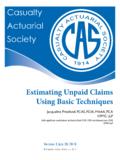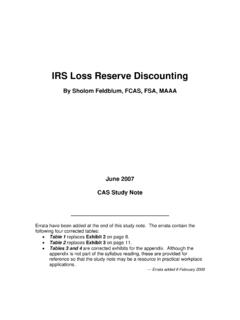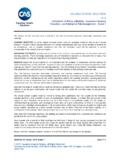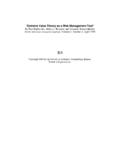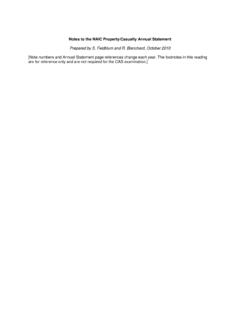Transcription of Casualty Actuarial Society
1 Estimating Unpaid Claims Using Basic TechniquesJacqueline Friedland, FCAS, FCIA, MAAA, FCAKPMG LLPWith significant contributions by Rachel Dutil, FCAS, FCIA and Edward Lam, FCASKPMG LLPC asualtyActuarialSocietyVersion 3, July 30, 2010 Casualty Actuarial Society , 2010 ESTIMATING UNPAID CLAIMS USING BASIC TECHNIQUES Jacqueline Friedland, FCAS, FCIA, MAAA, FCA KPMG LLP With significant contributions by Rachel Dutil, FCAS, FCIA and Edward Lam, FCAS KPMG LLP July 30 2010 Estimating Unpaid Claims Using Basic Techniques i Acknowledgments It has been a true honor and privilege to prepare this new text titled Estimating Unpaid Claims Using Basic Techniques for the Casualty Actuarial Society (CAS). Special thanks go to my KPMG colleagues Rachel Dutil and Edward Lam. Rachel read, proofed, critiqued, modified, and ultimately improved each and every draft version of this text.
2 Her contributions were tremendous at every step of the process. Edward Lam prepared all of the supporting exhibits and assisted with much of the research required for the text. He also reviewed most, if not all, of the draft versions. This text could not have been completed in such a timely manner without their invaluable input. I also want to thank my KPMG colleagues in Toronto and the United States who assisted in reviewing various versions of the text. Each member of the KPMG Toronto Actuarial Practice was involved at one point or another in reviewing this text. Thanks to members of the CAS Task Force for their input and feedback. Finally, I want to acknowledge the significant contributions of Ralph Blanchard, Edward Y. Yao, Wynand Viljoen, and Eugene van der Westhuizen. Their international experience and knowledge was particularly valuable in ensuring that the text will have relevance for actuaries practicing throughout the world.
3 The objective of the CAS in creating a new text that addressed the estimation of unpaid claims was to replace a number of readings that existed on the syllabus of basic education as of 2007 with a single educational publication. Thus, candidates preparing for the Actuarial exam addressing the estimation of unpaid claims using basic techniques would be able to replace numerous papers, which were written over a 30-year period, with a single text. Two major benefits of one educational publication are (1) consistent definitions of terms and (2) examples that are used with multiple estimation techniques. The CAS specified that the new text would focus on the learning objectives contained within the syllabus as of spring 2007. Furthermore, the CAS specifically requested that the new educational publication be written in a way as to be valuable to actuaries operating around the world.
4 In preparing Estimating Unpaid Claims Using Basic Techniques, I relied extensively on the following papers: Adler, M.; and Kline, Jr., Evaluating Bodily Injury Liabilities Using a Claims Closure Model, Evaluating Insurance Company Liabilities, Casualty Actuarial Society Discussion Paper Program, 1988, pp. 1-66. Berquist, ; and Sherman, , Loss Reserve Adequacy Testing: A Comprehensive, Systematic Approach, Proceedings of the Casualty Actuarial Society (PCAS) LXIV, 1977, pp. 123-184. Including discussion of paper: Thorne, , PCAS LXV, 1978, pp. 10-33. Bornhuetter, ; and Ferguson, , The Actuary and IBNR, PCAS LIX, 1972, pp. 181-195. Including discussions of paper: Cooper, , PCAS LX, 1973, pp. 161-164; and White, , PCAS LX 1973, pp. 165-168. Casualty Actuarial Society , Statement of Principles Regarding Property and Casualty Loss and Loss Adjustment Expense Reserves, May 1988.
5 Estimating Unpaid Claims Using Basic Techniques ii Fisher, ; and Lange, , Loss Reserve Testing: A Report Year Approach, PCAS LX, 1973, pp. 189-207. Including discussions of paper: Skurnick, D., PCAS LXI, 1974, pp. 73-83; and authors response, PCAS LXI, 1974, pp. 84-85. Fisher, ; and Lester, , Loss Reserve Testing in a Changing Environment, PCAS LXII, 1975, pp. 154-171. Mack, T. Credible Claims Reserve: The Benktander Method, ASTIN Bulletin, 2000, pp. 333-337. Pinto, E.; and Gogol, , An Analysis of Excess Loss Development, PCAS LXXIV, 1987, pp. 227-255. Including discussions of paper: Levine, , PCAS LXXIV, 1987, pp. 256-271; and Bear, , PCAS LXXIX, 1992, pp. 134-148. Wiser, ; Cockley, ; and Gardner A., Loss Reserving, Foundations of Casualty Actuarial Science (Fourth Edition), Casualty Actuarial Society , 2001, Chapter 5, pp. 197-285.
6 Throughout this text, I typically refer to these papers and other Actuarial papers by the author, publication source, and year of publication. It is important to recognize that learning objectives can change over time. To the extent that the CAS determines that new or different topics are appropriate for Actuarial candidates studying basic estimation techniques for unpaid claims, it is anticipated that this text will need to be modified accordingly. I have a request of readers of this text. Every effort has been made to ensure that all references and calculations are accurate. If we have inadvertently missed something, please contact me or the CAS so that future editions of the text can be corrected. Estimating Unpaid Claims Using Basic Techniques TABLE OF CONTENTS PART 1 INTRODUCTION Chapter 1 Overview .. 4 Chapter 2 The Claims Process .. 17 PART 2 INFORMATION GATHERING Introduction to Part 2 Information Gathering.
7 27 Chapter 3 Understanding the Types of Data Used in the Estimation of Unpaid Claims .. 28 Chapter 4 Meeting with Management .. 44 Chapter 5 The Development Triangle .. 51 Chapter 6 The Development Triangle as a Diagnostic Tool .. 63 PART 3 BASIC TECHNIQUES FOR ESTIMATING UNPAID CLAIMS Introduction to Part 3 Basic Techniques for Estimating Unpaid Claims .. 79 Chapter 7 Development Technique .. 84 Chapter 8 Expected Claims Technique .. 131 Chapter 9 Bornhuetter-Ferguson Technique .. 152 Chapter 10 Cape Cod Technique .. 174 Chapter 11 Frequency-Severity Techniques .. 194 Chapter 12 Case Outstanding Development Technique .. 265 Chapter 13 Berquist-Sherman Techniques .. 283 Chapter 14 Recoveries: Salvage and Subrogation and Reinsurance .. 329 Chapter 15 Evaluation of Techniques .. 345 1 Estimating Unpaid Claims Using Basic Techniques TABLE OF CONTENTS (continued) PART 4 ESTIMATING UNPAID CLAIM ADJUSTMENT EXPENSES Introduction to Part 4 Estimating Unpaid Claim Adjustment Expenses.
8 369 Chapter 16 Estimating Unpaid Allocated Claim Adjustment Expenses .. 370 Chapter 17 Estimating Unpaid Unallocated Claim Adjustment Expenses .. 386 APPENDICES STATEMENT OF PRINCIPLES AND Actuarial STANDARDS OF PRACTICE Appendix A Statement of Principles Regarding Property and Casualty Loss and Loss Adjustment Expense Reserves .. 419 Appendix B Actuarial Standard of Practice No. 43 Property/ Casualty Unpaid Claim Estimates .. 429 Appendix C Actuarial Standard of Practice No. 9 Documentation and Disclosure in Property and Casualty Insurance Ratemaking, Loss Reserving, and Valuations .. 440 2 Estimating Unpaid Claims Using Basic Techniques PART 1 INTRODUCTION Chapter 1 Overview .. 4 Chapter 2 The Claims Process .. 17 3 Estimating Unpaid Claims Using Basic Techniques Chapter 1 - Overview CHAPTER 1 OVERVIEW Importance of Accurately Estimating Unpaid Claims Accuracy in estimating unpaid claims is critical to insurers.
9 Unlike manufacturers, insurers may not know the true cost of goods sold during a financial reporting period until several years later. An insurer sells its promise to pay the policyholder or an injured party on behalf of the policyholder in the event of an occurrence covered by the insurance policy. For some insured events, the insurer is able to quantify the exact costs of settlement quickly and with great precision. For other insured events, the insurer may not know the ultimate cost for years, and possibly decades. Nevertheless, the insurer must report its financial results on a regular basis. Claim reserves (also known as technical provisions in some parts of the world) represent the insurer s estimate of its current liabilities for claims that occurred on or prior to the financial statement reporting date but that have not yet been paid. Actuaries around the world work with insurers and self-insurers to quantify, evaluate, and monitor estimates of unpaid claims.
10 We can look at the importance of accurately estimating unpaid claims from three viewpoints: Internal management Investors Regulators Internal Management From an internal management perspective, accuracy in the estimation of unpaid claims is essential for proper decision-making in virtually every area of an insurance company s operations including, but not limited to, pricing, underwriting, strategic, and financial decisions. An accurate estimate of unpaid claims is particularly important in pricing insurance products as inaccurate estimates could threaten the financial condition of an insurer. For example, an inadequate estimate of unpaid claims could drive an insurer to reduce its rates not realizing that the estimated unpaid claims were insufficient to cover historical claims. In this situation, the new lower rates would likely be insufficient to pay the claims that will arise from the new policies.

